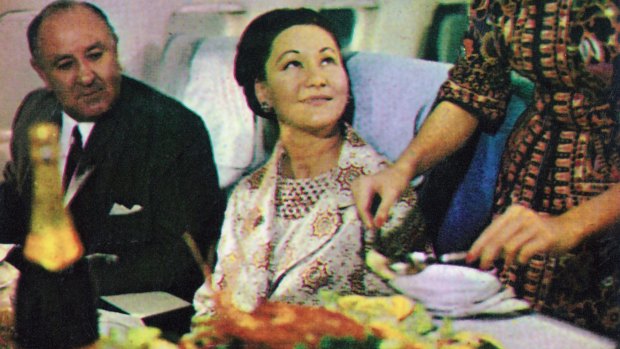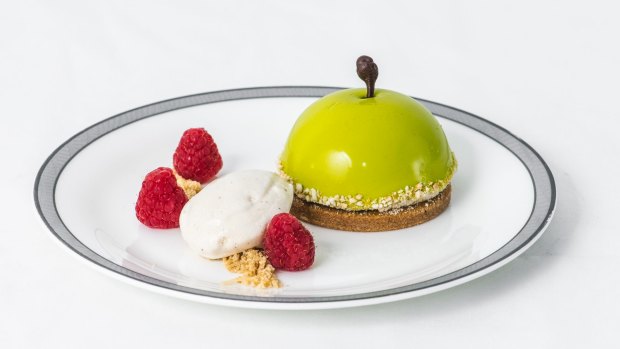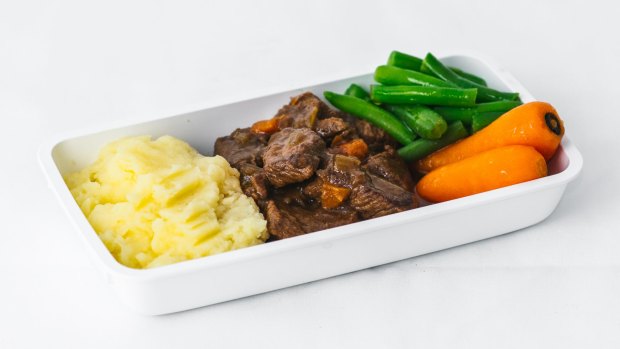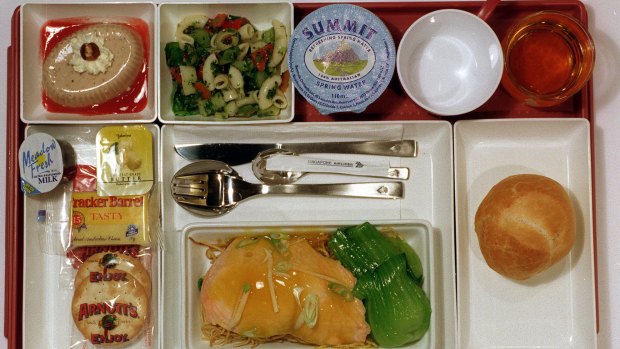This was published 7 years ago
Singapore Airlines celebrates 50 years of in-flight eating with kangaroo on the menu but not at 30,000 feet
By Steve Meacham

Singapore Airlines' culinary fare used to include a whole lobster for passengers travelling First Class in the 1970s.
So, when Singapore Airlines (SIA) decided last December to celebrate its 50th anniversary of flights to Australia this month with an Aussie-influenced menu, surely their chefs were keen to go "the kangaroo route"?
What about a whisper-thin wafer of wallaby? Or a choice cut of crocodile?
Jeremy Steele – executive chef for the Asian and Pacific region of Gate Gourmet, which produces up to 600,000 meals for 3100 flights per month for a squadron of airlines out of its kitchens near the perimeter of Sydney airport – admits he was keen to include kangaroo on the SIA's First Class menu.

An Australian Granny Smith apple dome with cinnamon ice cream has been created for Singapore Airline's special Australian-influenced menu.Credit: Alana Dimou
In fact he prepared a succulent roo tail for SIA's specialist tasting team and served it at the same Gate Gourmet private dining room where we are now gathered for a media launch in Mascot.
In December, everyone around the table agreed the roo was delicious. (Hardly a surprise: apart from being a former personal chef to a mega-wealthy Arab mogul, Steele was recently shortlisted as one of Australia's top five executive chefs).
But he couldn't convince the panel to take the risk. Why?

Cooper's Pale Ale braised Black Angus beef, seasonal vegetables and garlic mash, served on premium and economy class flights.Credit: Alana Dimou
"It's never been proven in the air," Steele explains. "Kangaroo doesn't replicate well at 30,000 feet."
"So why not try smoked kangaroo as a starter?" interjects the irrepressible Gayle Quarmby, an evangelist for native Australian foods.
She and husband, Mike, run a commercial nursery at Reedy Creek in South Australia and co-founded Outback Pride Fresh, which sources up to 64 bush tucker ingredients from remote indigenous communities in South Australia and the Northern Territory.

Economy class mean on Singapore Airlines from 2004.Credit: Sahlan Hayes
Once roos and crocs were ruled off the anniversary menu, Steele and the SIA team had to rethink.
They decided not only to use the quality Australian protein that does replicate well in the air – beef, chicken, prawns, salmon – but also utilise the full culinary palette of indigenous leaves, seeds, berries, flowers, roots and grasses that have sustained aboriginal Australians for 50,000 years. Quarmby calls the new menu "reconciliation on a plate".
Those of a certain generation will remember Bush Tucker Man, a cult documentary hit in the 1980s and 90s.
Major Leslie ("Les") Hiddins is a retired war veteran whose trademark bush gear is now part of the collection of the National Museum of Australia.
He was awarded a research scholarship to study survival skills in northern Australia during his army career, and is reputed to be the first person to discover that the Kakadu plum – used by indigenous peoples for time immemorial – has the highest concentration of vitamin C of any known substance on earth.
"Look, his heart was in the right place," Quarmby tells us, clearly not a fan.
"But the Bush Tucker Man set back native ingredients for a generation.
"His TV programs were all about survival skills. For years afterwards, if you talked about native ingredients Australians pulled a face and said: 'There's no way I am going to eat witchetty grubs!'."
Perhaps SIA should have invited Hiddins for this media launch of the celebration menu? What would the Bush Tucker Man think of that Business Class dish Steele and his team have invented: corn-fed chicken supreme stuffed with native mint bush and ricotta, with a lime-spiced chicken jus and celeriac puree?
Or the First Class offering: pan-seared Tasmanian salmon, rubbed with native aniseed myrtle, and served with a sea parsley-seasoned veloute?
"Sea parsley is European parsley on steroids," Quarmby tells us. "It clings to the rocks soaking up sea spray. That's what gives it such huge flavour. It takes a few moments before you recognise its peppery after-taste."
(To be fair to Hiddins, he was probably thinking soldiers defending the north from invasion might not have time to make a passable sea parsley-seasoned veloute.)
But then you could also see Hiddins "tuckering" into a few thick slices of that whole honey-glazed ham carved to order in front of First Class passengers on SIA's Boeing 747 flights to Singapore in the late 1970s.
As for that whole lobster, also served in First Class in the '70s?
Steele wouldn't risk it today.
He was keen to experiment with bugs (just to be clear: we're talking Balmain or Moreton Bay bugs, not Bogong moths). But again, "they don't replicate at 30,000 feet".
So your correspondent (and the rest of the undaunted media on this dangerous frontline assignment) are obliged to try the 50th anniversary equivalent on this year's First Class menu.
Prawns...
Admittedly, they're plump and sourced from Yamba, one of the most beautiful fisheries on the NSW coast. And yes, naturally they've been rubbed with native lemon myrtle and "oven flashed" before being served with pearl couscous and a native lime caviar vinaigrette.
Quarmby, meanwhile, is still salivating over the third of this year's First Class dishes.
Jack's Creek wagyu has been one of Australia's elite meat exports since 2000, lauded for its superbly marbled meat that comes from cross-breeding black angus with the four types of wagyu cattle so beloved by the Japanese.
But Quarmby is eager to talk about the steak's "salt bush and wild tomato" seasonings.
"Salt bush is a uniquely Australian product, a herb of the future," she says. "It requires less than 10 per cent of the water that western vegetables need, and it's high in zinc and magnesium.
"Instead of spending all that money on vitamin supplements, just grow some salt bush. Use it in tempura, or have it mashed in a salad – it's very diverse."
As for the bush tomato, "It grows out near Alice Springs. It has a sour taste appreciated in Asian cuisine, and it is full of nutrients.
"In traditional times, aboriginal Australians would gather a handful of bush tomatoes knowing that would keep them alive for three days until they found the next waterhole," Quarmby says.
I know what you're thinking. Like me, you can't afford to fly First or Business Class.
So what have Steele and Quarmby prepared for us in Premium and normal Economy?
Look, the Cooper's Pale-braised black angus with seasonal vegies and garlic mash is perfectly acceptable (the beer, Steele explains, is the extra Australian ingredient here, apart from the meat and vegetables of course).
But I'd go for the pan-roasted chicken breast with Ironbark honey jus (and I'm not even fond of chicken).
I suspect you won't believe me – but this was my favourite dish of the day (though, of course, at 35,000 feet it won't be served on good china plates with real cutlery).
Sadly, I had to skip the desserts... an ill child.
So I have no tasting notes on the Australian Granny Smith apple dome with cinnamon ice cream (First), the pear crumble with Daintree rainforest vanilla creme anglaise (Business), even the Connoisseur Murray river salted caramel ice cream (Economy).
Children! How come they're always ill when you're in "an important business meeting"?
For SIA's advanced meal requests see singaporeair.com/en
A SHORT HISTORY OF SIA'S CUISINE
* Before SIA split from Malaysia-Singapore Airlines (MSA), the first inflight catering consisted of pre-packed sandwiches, biscuits and cold-cuts.
* Passengers on longer flights had meals served in "tiffin trays", which kept the food moderately warm.
* The British-made de Havilland Comet was the first MSA plane to have onboard ovens, capable of reheating pre-prepared food. Breakfast was ham, sausages, baked beans and eggs. Lunch was a choice of steak or lamb chops.
* In the late '60s, a carvery service appeared as part of the First Class service.
* In the '70s, SIA became the first airline to serve complimentary drinks and meals in Economy.
Sign up for the Traveller Deals newsletter
Get exclusive travel deals delivered straight to your inbox. Sign up now.